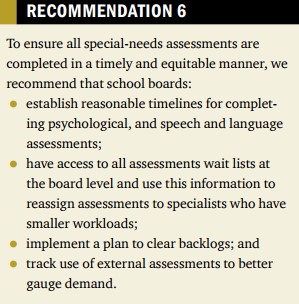Ontario's Auditor calls for review of funding formula

Auditor General Report 2017. Chapter 3: Ministry Funding and Oversight of School Boards
In her 2017 Annual report, the Auditor found that the Ministry of Education had failed to follow through on a key recommendation from an independent task force appointed by the government 2002. The Education Equality Task Force called for comprehensive reviews of the education funding formula every five years. According to the Auditor, there have been no such reviews, and current funding is based on out-of-date information.
Among other things, the report found that:
- benchmarks in the funding formula – which are a combination of the factor that triggers a cost (e.g. the intended number of staff per 1,000 students) and the dollar amount assigned to that factor (e.g. the average cost to fund one staff member) – are out-of-date.
- the Ministry of Education does not assess whether students with similar needs receive the same level of support no matter where they live in the province.
- the Ministry does not confirm that special purpose funding is spent as intended, does not allocate funding based on actual needs, and does not analyze whether additional funding provided for some students is actually achieving the intended results.
- almost 80% of school boards spent at least $100,000 more than their allocated amount for special education, with one board spending as much as $81 million more than allocated.
According to the report, the Ministry of Education updates benchmarks connected to labour costs regularly, but other benchmarks related to things like socio-economic and demographic factors, or hard costs such as computers, are not updated on a regular basis.
Concerns about special education funding and waiting lists
The Auditor reported that half of special education funding is allocated to boards based on their overall enrolment, as opposed to the number of students receiving special education programs and services. She said that this may create difficulties for some boards, particularly those ones with higher proportions of students receiving special education support. The proportions of students enrolled in special education range from 8% in some boards to as high as 28% in others.
The report also raised concerns about the impact of out-of-date benchmarks on boards’ special education funding. Part of special education funding is based on boards’ demographics, but the Ministry is using census data from Statistics Canada that is more than 10 years old.
“Given that demographics in Ontario may have significantly changed since 2006, using this data may not fairly and equitably reflect how funding should be distributed so that students who need it most are receiving it.”
The Auditor also raised concerns about waiting lists for special education supports, and about the number of families who are paying privately for external assessments.

Auditor General’s Report 2017. Chapter 3: School Boards’ Management of Financial and Human Resources
In a more in-depth review, the Auditor found that in some boards, nearly a quarter of students who may have special education needs are waiting longer than a year to receive psychological assessments.
Increasingly, parents are paying for private assessments in order to avoid wait times. In one board, the number of external, privately paid for psychological assessments increased by 78%, from 354 in the 2012/13 school year to 631 in 2016/17. The report says that with external assessments, “these special-needs students can receive services tailored to their unique needs sooner.”
Health and Physical Education
The Auditor also followed up on recommendations made in a 2013 report focused on Ontario’s Healthy Schools Strategy. While the follow-up report outlined some progress on improving communications with parents to ” to encourage healthier eating and increased physical activity,” and on the implementation of the province’s School Food and Beverage Policy, the report says that the Ministry “has not made much progress on the recommendation to set goals and targets for school boards to increase physical activity in schools, and periodically monitor, measure, and publicly report on the progress made.”
To read the full report, click here.
